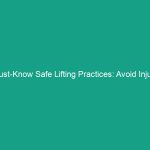Introduction
In today’s fast-paced work environments, ensuring Health, Safety, and Environment (HSE) standards is paramount. Load handling and rigging Safety are critical components of Workplace Safety that demand attention. Whether operating cranes, hoists, or any load-lifting equipment, the risks involved can be significant. It is essential to implement effective Safety Guidelines to mitigate these risks.
This article will explore vital load handling and rigging Safety guidelines that help avoid common risks. By adhering to these practices, organizations can protect their employees, reduce accidents, and ensure compliance with regulatory frameworks. Let’s delve into the core aspects of load handling and rigging safety to promote a safer working environment.
Understanding Regulatory Frameworks
Regulatory frameworks play a crucial role in establishing safety Standards for load handling and rigging. Various organizations and governmental bodies have set forth guidelines that dictate how operations should be conducted to ensure safety.
Key Regulatory Bodies
Some of the key regulatory bodies involved in load handling and rigging safety include:
- Occupational Safety and Health Administration (OSHA): osha sets and enforces standards to ensure safe working conditions in the U.S. Their Regulations on load handling are strict and comprehensive.
- American National Standards Institute (ANSI): ANSI develops consensus standards, including those related to rigging and lifting practices.
- National Institute for Occupational Safety and Health (NIOSH): NIOSH conducts research and makes recommendations to prevent workplace injuries and illnesses.
Compliance and Its Importance
Compliance with these regulations is not merely a legal obligation but also a moral one. Ensuring that all Procedures align with established standards can significantly reduce the risk of accidents. Moreover, regular audits and inspections help in maintaining adherence to these guidelines.
Companies that prioritize compliance not only safeguard their employees but also enhance their reputation and operational efficiency. Non-compliance can lead to severe consequences, including hefty fines, legal issues, and most importantly, workplace injuries.
Best Practices for Load Handling and Rigging Safety
Implementing Best Practices for load handling and rigging safety is essential for reducing risks. These practices encompass various aspects, from Training to equipment Maintenance.
Training and Certification
One of the most effective ways to enhance load handling and rigging safety is through comprehensive training programs. Employees should receive training that covers:
- Understanding equipment and its limitations.
- Recognizing Hazards associated with load handling.
- Proper rigging techniques and load securement.
- Emergency procedures and rescue plans.
Certification programs ensure that personnel are proficient in Safe Practices and understand the significance of load handling and rigging safety. Regular refresher courses should also be mandated to keep skills and knowledge up to date.
Equipment Inspection and Maintenance
Regular inspection and maintenance of lifting equipment are vital in preventing accidents. Operators should adhere to the following practices:
- Conduct daily inspections before use to check for wear and damage.
- Ensure that all rigging gear, such as slings, hooks, and chains, are in good condition.
- Follow a scheduled maintenance program as per manufacturer recommendations.
Documenting inspections and maintenance activities not only helps in tracking equipment conditions but also provides evidence of compliance during audits.
Load Assessment and Planning
Before any lifting Operation, a thorough load assessment should be conducted. This involves evaluating the weight of the load, its center of gravity, and environmental factors such as wind and space constraints. Planning is crucial and should include:
- Determining the right equipment for the specific load.
- Establishing a clear communication plan among team members.
- Designating a qualified person to oversee the operation.
By carefully assessing and planning, teams can significantly reduce the chances of mishaps during lifting operations.
Case Studies: Lessons Learned from Past Incidents
Learning from past incidents can provide valuable insights into improving load handling and rigging safety practices. Here are a few notable case studies.
Case Study 1: The Bridge Collapse
In 2018, a bridge construction project experienced a catastrophic failure during the lifting of a pre-fabricated section. An investigation revealed that inadequate load assessment and communication were major contributing factors. The load exceeded the rated capacity of the equipment, and workers were not trained to recognize the signs of overloading.
This incident underscored the importance of thorough load planning and the need for ongoing training in load handling and rigging safety. Following this event, the construction company implemented a robust training program and revised their load assessment protocols.
Case Study 2: The Warehouse Incident
A well-known warehouse faced a significant safety breach when a load fell during a routine lifting operation, injuring two employees. The investigation revealed that the rigging was improperly secured, and the personnel involved lacked adequate training. This incident highlighted the critical nature of proper rigging techniques and the importance of certification for all operators.
As a result of this incident, the warehouse instituted stricter safety protocols, including mandatory training sessions and regular drills to reinforce rigging safety practices.
Challenges in Load Handling and Rigging Safety
Despite the best efforts to improve load handling and rigging safety, several challenges persist. Addressing these challenges is essential for enhancing Workplace Safety.
Human Factors
Human error remains one of the leading causes of accidents in load handling. Factors such as fatigue, lack of training, and communication breakdowns can lead to oversight and mistakes. Organizations must focus on fostering a culture of safety where employees feel empowered to report unsafe conditions and practices.
Technological Limitations
While technology has advanced significantly in the field of load handling, some organizations may still rely on outdated practices and equipment. Investing in modern lifting equipment that incorporates safety features such as load monitoring systems can help mitigate risks.
Regulatory Compliance Challenges
Keeping up with the ever-evolving regulatory landscape can be challenging for organizations. Ensuring compliance requires continuous education and adaptation to new standards. Companies must prioritize staying informed about regulatory changes and aligning their practices accordingly.
Future Trends in Load Handling and Rigging Safety
The future of load handling and rigging safety is likely to be influenced by technological advancements and an increasing focus on safety culture. Here are some trends to watch.
Increased Use of Automation
Automation is poised to play a significant role in load handling. Automated cranes and robotic systems can reduce human involvement in dangerous lifting operations, thereby minimizing risks. As this technology develops, organizations will need to adapt their training and safety protocols accordingly.
Data-Driven Safety Practices
With the rise of big data and analytics, organizations can analyze safety performance metrics to identify trends and areas for improvement. By utilizing data, companies can develop targeted training programs and implement proactive measures to enhance load handling and rigging safety.
Enhanced Training Through Virtual Reality
Virtual reality (VR) training is becoming an innovative approach to safety training. VR can simulate real-world scenarios, allowing employees to practice load handling and rigging techniques in a safe environment. This immersive experience can significantly improve retention and understanding of safety protocols.
Conclusion
In summary, load handling and rigging safety are integral components of Workplace Health and safety. By adhering to regulatory frameworks, implementing Best Practices, learning from past incidents, and addressing ongoing challenges, organizations can create a safer working environment for all. The future of load handling and rigging safety promises exciting advancements that can further enhance safety protocols.
It is imperative that every organization takes the necessary steps to prioritize load handling and rigging safety. By fostering a safety-first culture and investing in continuous training and technology, we can work together to minimize risks and protect our most valuable asset—our employees. Take action today to ensure robust safety practices in your organization!


